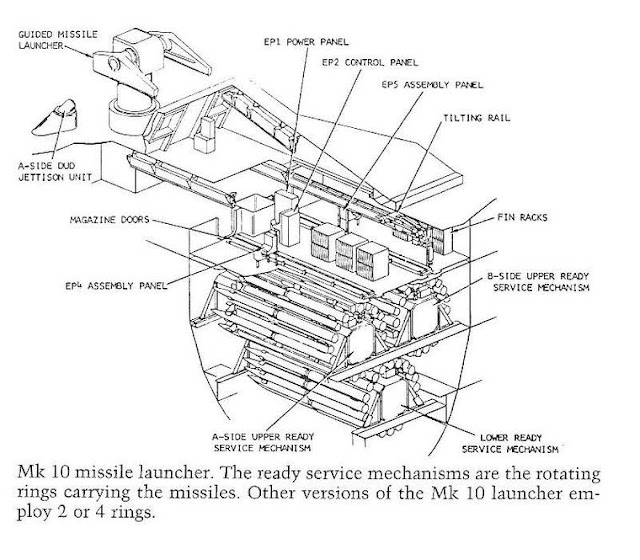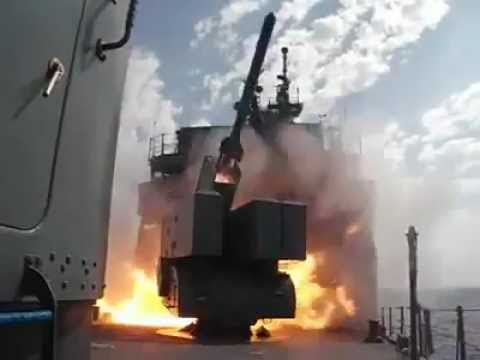Il missile ASROC (Anti Submarine ROCket, razzo antisommergibili) è un semplice ma diffuso missile ASW, armato con un siluro Mk 46. È un'arma compatta, lanciabile da lanciatori ottupli o da celle verticali, se in apposita versione. La sua forza è stata la semplicità complessiva data dalla non ricerca di prestazioni eccessive, per le quali sarebbero stati più adatti elicotteri o velivoli imbarcati.
Sviluppo
Lo sviluppo dell'ASROC iniziò nei primi anni '50, in quanto, tra il 1952 e il 1954, la Naval Ordnance Test Station iniziò lo sviluppo dei nuovi lanciasiluri denominati Rat A e Rat B. Le prestazioni non furono però soddisfacenti per i comandi militari, tanto che nel 1955 venne creata una nuova versione che fu denominata ASROC in riferimento al fatto che il lanciasiluri poteva lanciare anche ordigni dotati di testata nucleare. La Honeywell vinse il bando di produzione nel 1956 e nel 1960 vennero condotti i primi test a bordo di unità della United States Navy. Nel maggio del 1962 vennero eseguiti i primi test che impiegavano armamenti atomici. Nel 1963 l'ASROC venne denominato RUR-5A. In seguito, negli anni '80, vennero dati ai sistemi di lancio le nuove nomencalure di RUR-5B, RUR-5C e RUR-5D, per segnalare il diverso tipo di munizioni impiegato. Con l'esaurirsi della guerra fredda, i sistemi ASROC tarati per i lanci atomici vennero tutti dismessi per onorare i vari accordi sul disarmo nucleare. A partire dagli anni '90 alcuni ASROC vennero aggiornati alla versione F. Dopo il 2000, la produzione dell'ASROC, che contava all'incirca un migliaio di unità, venne interrotta e i vari pezzi iniziarono ad essere sostituiti con nuovi lanciatori.
Durante il proprio servizio, l'ASROC, fatta esclusione per i test del 1962, non è mai stato impiegato per lanci atomici contro bersagli nemici.
Tecnica
Il lanciatore può rivelare la presenza di eventuali bersagli nemici tramite un sonar. Dopo l'identificazione e il puntamento del bersaglio, l'ASROC lancia in verticale un missile con all'interno un siluro. Dopo lo spegnimento del propulsore del missile, il siluro viene distaccato e inizia la discesa verso l'acqua dopo l'apertura di un paracadute che ha il compito di frenare la caduta verticale. Dopo l'ingresso in acqua, il siluro attiva il proprio propulsore e si dirige sul bersaglio tramite il sonar. Nel caso di lancio di cariche di profondità, il lanciatore attiva un timer che predetermina il tempo di esplosione delle bombe di profondità. L'ASROC può essere equipaggiato con siluri MK44 e MK16, cariche nucleari W44 e missili antiaerei MK26.
Operatori ed ex operatori:
- Marina brasiliana
- Royal Canadian Navy - solo su cacciatorpediniere di classe Restigouche (dopo la modifica IRE/DELEX).
- Marina tedesca - solo su cacciatorpediniere di classe Lütjens
- Marina ellenica
- Marina Militare Italiana - fu imbarcato solo sul Vittorio Veneto con un lanciatore Mk 10 GMLS (deposito per 40 missili, tra RIM-2 Terrier / RIM-67A SM-1ER e ASROC)
- Forza di autodifesa marittima giapponese
- Marina messicana
- Repubblica di Corea Marina Militare
- Marina del Pakistan
- Marina spagnola
- Repubblica di Cina Marina Militare
- Royal Thai Navy
- Forze navali turche
- Marina degli Stati Uniti e Guardia Costiera degli Stati Uniti - le stesse configurazioni della Marina degli Stati Uniti sono state impiegate anche su alcune unità Hamilton Class Cutter 378' della Guardia Costiera degli Stati Uniti durante gli anni '70 e all'inizio degli anni '80.
ENGLISH
The RUR-5 ASROC (for "Anti-Submarine ROCket") was an all-weather, all sea-conditions anti-submarine missile system. Developed by the United States Navy in the 1950s, it was deployed in the 1960s, updated in the 1990s, and eventually installed on over 200 USN surface ships, specifically cruisers, destroyers, and frigates. The ASROC has been deployed on scores of warships of many other navies, including Canada, Germany, Italy, Japan, the Republic of China, Greece, Pakistan and others.
History
ASROC started development as the Rocket Assisted Torpedo (RAT) program by the Naval Ordnance Test Station at China Lake in the early 1950s to develop a surface warship ASW weapon counter to the new post-World War II submarines which ran quieter, at much higher speed and could attack from much longer range with high speed homing torpedoes. In addition, the goal was to take advantage of modern sonars with a much larger detection range. An extended range torpedo delivered by parachute from the air would allow warships the stand-off capability to attack hostile submarines with very little advance notice to the hostile submarine. The RAT program came in three phases: RAT-A, RAT-B and RAT-C. RAT-A (and its follow-on, RAT-B) were efforts to develop a compact and economical stand-off ASW for smaller warships, but were found to be either unreliable or had too short a range. RAT-C was a program to develop a stand-off ASW weapon that used a nuclear depth charge. This would require a range of at least 8,000 yards to escape potential damage from the underwater blast. Unlike the original RAT program rockets, the RAT-C was considerably larger to accomplish the extended range needed and was to be fitted to larger warships. With the failure of both the RAT-A and RAT-B programs, RAT-C was redesigned from a stand-off nuclear ASW weapon to one that could use not only a nuclear depth charge but also a homing ASW torpedo. To obtain the accuracy needed, the RAT-C rocket launcher had to be redesigned with larger side fins. This program finally combined reliability and accuracy, along with the necessary stand-off range. However, before RAT-C reached initial operational status in 1960 aboard the large US Navy destroyer leader USS Norfolk, its name was changed to the present ASROC. ASROC was first deployed in 1961 and eventually made the vast majority of USN surface combatants nuclear-capable.
Description
The first ASROC system using the MK-112 "Matchbox" launcher was developed in the 1950s and installed in the 1960s. This system was phased out in the 1990s and replaced with the RUM-139 Vertical Launch ASROC, or "VLA".
After a surface ship, patrol plane or anti-submarine helicopter detects an enemy submarine by using sonar or other sensors, it could relay the sub's position to an ASROC-equipped ship for attack. The attacking ship would then fire an ASROC missile carrying an acoustic homing torpedo or a W44 Nuclear Depth Bomb onto an unguided ballistic trajectory toward the target. At a pre-determined point on the missile's trajectory, the payload separates from the missile and deploys a parachute to permit splashdown and water entry at a low speed and with minimum detectable noise. Water entry activates the torpedo, which is guided by its own sonar system, and homes in on the target using either active sonar or passive sonar.
W44 nuclear depth charge
The W44 nuclear depth charge entered service in 1961, but was never used beyond one or two tests before the Limited Nuclear Test Ban Treaty banning underwater nuclear tests went into effect. A total of 575 weapons were produced. The W44 weighed 77 kg (170 lb) with a diameter of 35 cm (13.75 in) and length of 64 cm (25.3 in). Following payload separation, the unguided W44 sank quickly to a predetermined depth where the 10-kiloton warhead detonated. The nuclear-armed ASROC was never used in combat. W44-armed ASROC missiles were retired by 1989, when all types of nuclear depth bombs were removed from deployment.
Specific installations
One of the first ASROC installations was on USS Norfolk (DL-1) in 1960. The first large group of ships to receive ASROC were 78 Gearing-class destroyers, modified under the Fleet Rehabilitation and Modernization Mark I program (FRAM I) in the early 1960s. A Mark 112 8-tube ASROC launcher was added along with other major modifications. ASROC reloads were stowed alongside the helicopter hangar and handled by a small crane.
The 31 U.S. Navy Spruance-class destroyers were all built with the Mark 16 Mod 7 ASROC Launching Group and MK 4 ASROC Weapons Handling System (AWHS) reload system. These had one standard Mark 112 octuple ASROC launcher, located immediately above a reload system holding an additional 16 assembled rounds (two complete reloads of eight missiles apiece). Thus, each Spruance-class destroyer originally carried a maximum total of 24 ASROC.
Most other US Navy and allied navy destroyers, destroyer escorts, frigates, and several different classes of cruisers only carried the one ASROC "matchbox" MK 112 launcher with eight ASROC missiles (although later in service, some of those missiles could be replaced by the Harpoon anti-ship missile). The "matchbox" Mk 112 launchers were capable of carrying a mixture of the two types. Reloads were carried in many classes, either on first level of the superstructure immediately abaft the launcher, or in a separate deckhouse just forward or abaft the Mk 112.
The MK 16 Launching Group also had configurations that supported RGM-84 Harpoon (onboard Knox-class destroyer escorts (frigates)) or a variation of the Tartar missile in limited distribution.
Ships with the Mk 26 GMLS, and late marks of the Mk 10 GMLS aboard the Belknap-class cruisers, could accommodate ASROC in these power-loaded launchers (the Mk 13 GMLS was not able to fire the weapon, as the launcher rail was too short).
Most Spruance-class destroyers were later modified to include the Mk 41 VLS, these launchers are capable of carrying a mixture of the RUM-139 VL-ASROC, the Tomahawk TLAM, and other missiles. All of the Spruance destroyers carried two separate quad Harpoon launchers. Other US ships with the Mk 41 can also accommodate VL-ASROC.
Operators
Former operators:
- Brazilian Navy
- Royal Canadian Navy - only on Restigouche-class destroyers (after IRE/DELEX modification.)
- German Navy - only on Lütjens-class destroyers
- Hellenic Navy
- Italian Navy - only on Vittorio Veneto using a Mk 10 GMLS launcher (depot for 40 missiles, between RIM-2 Terrier / RIM-67A SM-1ER and ASROC)
- Japan Maritime Self-Defense Force
- Mexican Navy
- Republic of Korea Navy
- Pakistan Navy
- Spanish Navy
- Republic of China Navy
- Royal Thai Navy
- Turkish Naval Forces
- United States Navy and United States Coast Guard - same configurations as US Navy were also deployed on some United States Coast Guard 378' High Endurance Hamilton Class Cutters during the 1970s and early 1980s.
(Web, Google, Wikipedia, You Tube)





























Nessun commento:
Posta un commento
Nota. Solo i membri di questo blog possono postare un commento.